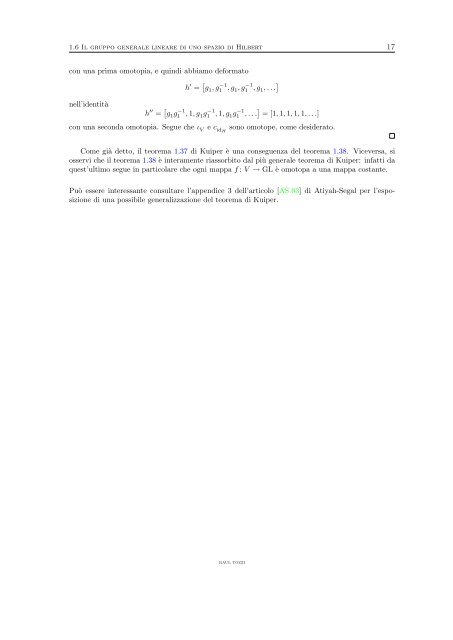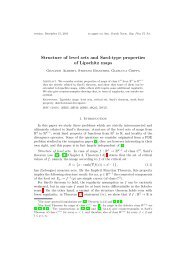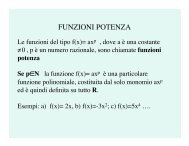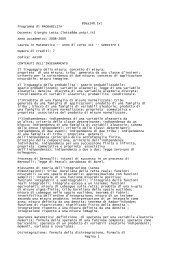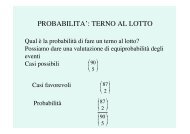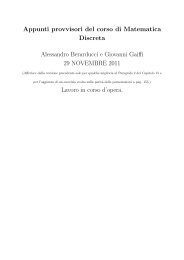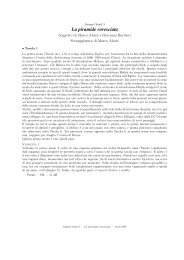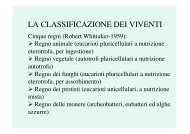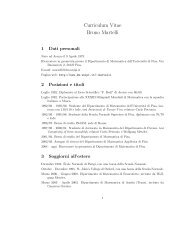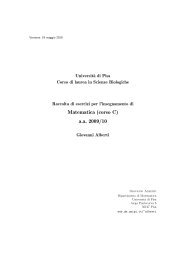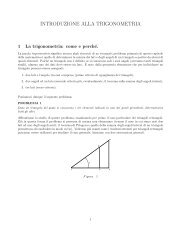16 Fenomeni della <strong><strong>di</strong>mensione</strong> <strong>in</strong>f<strong>in</strong>ita co<strong>in</strong>cide evidentemente con g. Esibiremo nel seguito due omotopie che deformeranno successivamente attraverso elementi <strong>di</strong> GL ogni elemento g ∈ V <strong>in</strong> c (g) = id idH H ∈ GL. Precisamente, def<strong>in</strong>iremo una prima omotopia da g = h a h ′ , <strong>in</strong> cui h ′ è data dalla matrice <strong>in</strong>f<strong>in</strong>ita ⎧ h ⎪⎨ ⎪⎩ ′ ij = 0 h se i = j, ′ 2i,2i = g−1 1 se i ≥ 1, h ′ 2i+1,2i+1 = g1 se i ≥ 1, h ′ 11 = g1 e qu<strong>in</strong><strong>di</strong> def<strong>in</strong>iremo una seconda omotopia da h ′ a h ′′ , essendo ⎧ ⎪⎨ h ⎪⎩ ′′ ij = 0 se i = j, h ′′ −1 2i−1,2i−1 = g1g1 = 1 se i ≥ 1, se i ≥ 1, h ′′ 2i,2i i.e., h ′ = g 1, g −1 1 , g 1, g −1 1 , g 1, . . . i.e., h ′′ = g 1g −1 1 , 1, g 1g −1 1 , 1, g 1g −1 1 , . . . = [1, 1, 1, 1, 1, . . .]. Una omotopia da h a h ′ è la seguente, applicata ad ogni coppia <strong>di</strong> elementi consecutivi della <strong>di</strong>agonale <strong>di</strong> h (gli altri essendo tutti zero) a partire dal secondo elemento: −1 cos θ − s<strong>in</strong> θ g1 0 cos θ s<strong>in</strong> θ g θ ∈ [0, π/2] ↦−→ 1 0 . (1.6.2) s<strong>in</strong> θ cos θ 0 1 − s<strong>in</strong> θ cos θ 0 1 La mappa 1.6.2 realizza una omotopia tra [g −1 1 g1, 1] (θ = 0) e [g −1 1 , g1] (θ = π/2). Infatti, quando θ varia <strong>in</strong> [0, π/2], cos θ − s<strong>in</strong> θ g1 0 s<strong>in</strong> θ cos θ 0 1 va da g1 0 0 −1 0 1 a g1 0 . Così, quando θ va da 0 a π/2, cos θ − s<strong>in</strong> θ g1 0 cos θ s<strong>in</strong> θ s<strong>in</strong> θ cos θ 0 1 − s<strong>in</strong> θ cos θ va da g1 0 1 0 0 1 a 0 g1 . Si deduce qu<strong>in</strong><strong>di</strong> che per θ <strong>in</strong> [0, π/2], (1.6.2) realizza una omotopia tra −1 −1 g1 g1 0 g e 1 0 . 0 1 0 g1 È facile <strong>di</strong>mostrare che gli operatori l<strong>in</strong>eari che deformano h <strong>in</strong> h ′ al variare <strong>di</strong> θ <strong>in</strong> ]0, π/2[ sono tutti cont<strong>in</strong>ui. Inoltre è standard riparametrizzare questa trasformazione, parametrizzata da 0 a π/2, <strong>in</strong> una usuale omotopia parametrizzata tra 0 e 1. Allo stesso modo si determ<strong>in</strong>a una omotopia da h ′ a h ′′ , stavolta applicata ad ogni coppia <strong>di</strong> elementi consecutivi della <strong>di</strong>agonale <strong>di</strong> h ′ , a partire dal primo: cos θ − 1 θ ∈ [0, π/2] ↦−→ 1 − s<strong>in</strong> θ −1 s<strong>in</strong> θ − 1 g1 cos θ − 1 0 0 cos θ − 1 1 s<strong>in</strong> θ − 1 1 − s<strong>in</strong> θ g1 cos θ − 1 0 0 . 1 (1.6.3) La mappa 1.6.3 realizza una omotopia tra [g1, g −1 1 ] (θ = 0) e [1, 1] (θ = π/2). Come prima, si <strong>di</strong>mostra facilmente che gli operatori l<strong>in</strong>eari che deformano h ′ <strong>in</strong> h ′′ al variare <strong>di</strong> θ <strong>in</strong> ]0, π/2[ sono tutti cont<strong>in</strong>ui; <strong>in</strong>oltre si può riparametrizzare questa trasformazione <strong>in</strong> una usuale omotopia parametrizzata tra 0 e 1. Riassumendo, abbiamo deformato successivamente g = [g1, 1, 1, 1, 1, . . .] = h = g1, g −1 1 g1, 1, g −1 1 g1, 1, . . . <strong>in</strong> h ′ = g 1, g −1 1 , g 1, g −1 1 , g 1, . . . IMMERSIONI APERTE IN DIMENSIONE INFINITA
1.6 Il gruppo generale l<strong>in</strong>eare <strong>di</strong> uno spazio <strong>di</strong> Hilbert 17 con una prima omotopia, e qu<strong>in</strong><strong>di</strong> abbiamo deformato nell’identità h ′ = g 1, g −1 1 , g 1, g −1 1 , g 1, . . . h ′′ = g 1g −1 1 , 1, g 1g −1 1 , 1, g 1g −1 1 , . . . = [1, 1, 1, 1, 1, . . .] con una seconda omotopia. Segue che ι V e c idH sono omotope, come desiderato. Come già detto, il teorema 1.37 <strong>di</strong> Kuiper è una conseguenza del teorema 1.38. Viceversa, si osservi che il teorema 1.38 è <strong>in</strong>teramente riassorbito dal più generale teorema <strong>di</strong> Kuiper: <strong>in</strong>fatti da quest’ultimo segue <strong>in</strong> particolare che ogni mappa f : V → GL è omotopa a una mappa costante. Può essere <strong>in</strong>teressante consultare l’appen<strong>di</strong>ce 3 dell’articolo [AS 03] <strong>di</strong> Atiyah-Segal per l’esposizione <strong>di</strong> una possibile generalizzazione del teorema <strong>di</strong> Kuiper. RAUL TOZZI


